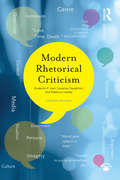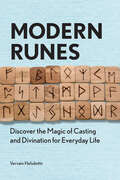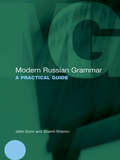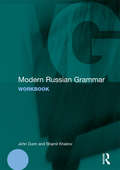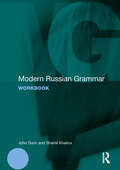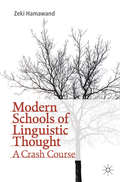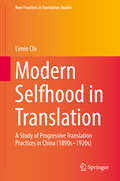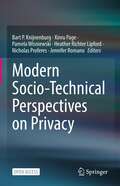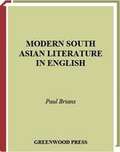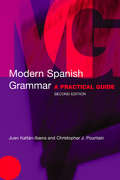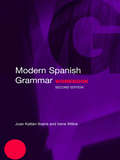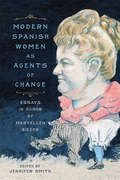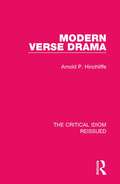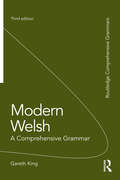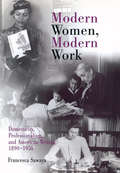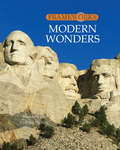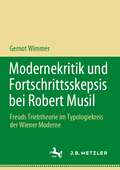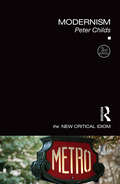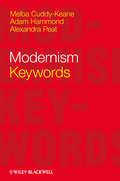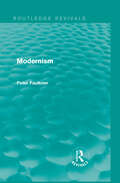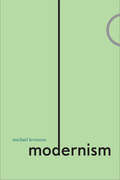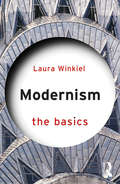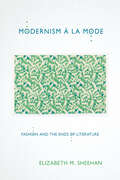- Table View
- List View
Modern Rhetorical Criticism
by Roderick P Hart Suzanne M. Daughton Rebecca LavallyA comprehensive and up-to-date introduction to the analysis of public rhetoric, Modern Rhetorical Criticism teaches readers how to examine and interpret rhetorical situations, ideas, arguments, structure, and style. The text covers a wide range of critical techniques, from cultural and dramatistic analysis to feminist and Marxist approaches. A wealth of original criticism demonstrates how to analyze such diverse forms as junk mail, campaign speeches, and popular entertainment, as well as literature. This long-awaited revision offers specific guidance on crafting analytic essays, and contains new coverage of legacy as well as new media, identity criticism, and post-colonial and decolonial criticism. The fourth edition also offers additional resources online for instructors and students.
Modern Runes: Discover the Magic of Casting and Divination for Everyday Life
by Vervain HelsdottirUnlock the incredible power of rune casting—ancient magic for the modern day The practice of magic may be less common today, but it certainly hasn't been forgotten. Modern Runes shows you how to draw upon the wisdom inherent in these ancient symbols and bring the arts of runic divination and magic into your life. Focused on the Elder Futhark—the oldest runic alphabet—this complete guide offers simple and straightforward ways to help you unlock the mysteries of runes and bring their power into the modern world. From choosing your rune set to navigating runic spreads to creating talismans, you'll discover everything you need to become a practitioner of this deeply spiritual art. Modern Runes includes: Runic history—Explore the origins of the runes as you dive into the history and mythology surrounding them, as well as how they were originally used. Modern magic—Bring runic magic into the modern day with guides to casting, interpretation, and divination perfectly suited for today's practitioners, while remaining rooted in tradition. Understanding the Elder Futhark—Master the meanings behind runes and discover how they can be cleansed, consecrated, charged, read—including reversed runes—and used in your day-to-day life. Unlock the secrets of runes and make their magic a part of your day.
Modern Russian Grammar: A Practical Guide (Modern Grammars #Vol. 3)
by John Dunn Shamil KhairovModern Russian Grammar: A Practical Guide is an innovative reference guide to Russian, combining traditional and function-based grammar in a single volume. The Grammar is divided into two parts. Part A covers traditional grammatical categories such as agreement, nouns, verbs and adjectives. Part B is carefully organized around language functions covering all major communication situations. With a strong emphasis on contemporary usage, all grammar points and functions are richly illustrated with examples. Main features of the Grammar include: clear explanations emphasis on areas of particular difficulty for learners of Russian, such as numerals and verbs of motion extensive cross-referencing between the different sections. This is the ideal reference grammar for learners of Russian at all levels, from beginner to advanced. No prior knowledge of grammatical terminology is assumed and a glossary of grammatical terms is provided.
Modern Russian Grammar Workbook
by John Dunn Shamil KhairovModern Russian Grammar Workbook is an innovative book of exercises and language tasks for all learners of Russian. The book is divided into two parts. Section 1 provides exercises based on essential grammatical structures. Section 2 practises everyday functions such as making introductions, apologizing and expressing needs. A comprehensive answer key at the back of the book enables students to check on their progress. Main features include: exercises graded according to level of difficulty cross referencing to the related Modern Russian Grammar topical exercises which develop students’ vocabulary base. The Modern Russian Grammar Workbook is ideal for all learners of Russian, from beginner to intermediate and advanced students. It can be used both independently and alongside the Modern Russian Grammar: A Practical Guide, also published by Routledge. John Dunn is Honorary Research Fellow and Shamil Khairov is Lecturer in Russian, both at the School of Modern Languages and Cultures, University of Glasgow.
Modern Russian Grammar Workbook (Modern Grammar Workbooks)
by John Dunn Shamil KhairovModern Russian Grammar Workbook is an innovative book of exercises and language tasks for all learners of Russian. The book is divided into two parts. Section 1 provides exercises based on essential grammatical structures. Section 2 practises everyday functions such as making introductions, apologizing and expressing needs. A comprehensive answer key at the back of the book enables students to check on their progress. Main features include: exercises graded according to level of difficulty cross referencing to the related Modern Russian Grammar topical exercises which develop students’ vocabulary base. The Modern Russian Grammar Workbook is ideal for all learners of Russian, from beginner to intermediate and advanced students. It can be used both independently and alongside the Modern Russian Grammar: A Practical Guide, also published by Routledge. John Dunn is Honorary Research Fellow and Shamil Khairov is Lecturer in Russian, both at the School of Modern Languages and Cultures, University of Glasgow.
Modern Sanskrit Literature: Traditions and Innovations
by S. B. RaghunathacharyaMany people believe firmly that Sanskrit is a tradition bound, and that reforms or innovations are not acceptable to it. Based on this belief they conclude that Sanskrit literature has no relevance to the present day society.
Modern Schools of Linguistic Thought: A Crash Course
by Zeki HamawandThis textbook provides a clear and concise overview of the main schools of linguistic thought and scholarship from the late 18th century to the present day, examining the key tenets and leading figures of each approach and assessing their impact on the field. Combining theory with practice, the author aims to familiarise students with the mechanisms used in analysing language structures, to acquaint them with the history of the discipline, and to demonstrate how different - sometimes competing - approaches can be combined to understand language and linguistics today. Written in an engaging and accessible manner, this textbook is an ideal primer for new students of linguistics at any level, as well as more experienced researchers seeking to understand the history of their field or the arguments and theories of other sub-disciplines.
Modern Selfhood in Translation: A Study Of Progressive Translation Practices In China (1890s-1920s) (New Frontiers In Translation Studies)
by Limin ChiThis book examines the development of Chinese translation practice in relation to the rise of ideas of modern selfhood in China from the 1890s to the 1920s. The key translations produced by late Qing and early Republican Chinese intellectuals over the three decades in question reflect a preoccupation with new personality ideals informed by foreign models and the healthy development of modern individuality, in the face of crises compounded by feelings of cultural inadequacy. The book clarifies how these translated works supplied the meanings for new terms and concepts that signify modern human experience, and sheds light on the ways in which they taught readers to internalize the idea of the modern as personal experience. Through their selection of source texts and their adoption of different translation strategies, the translators chosen as case studies championed a progressive view of the world: one that was open-minded and humanistic. The late Qing construction of modern Chinese identity, instigated under the imperative of national salvation in the aftermath of the First Sino-Japanese War, wielded a far-reaching influence on the New Culture discourse. This book argues that the New Culture translations, being largely explorations of modern self-consciousness, helped to produce an egalitarian cosmopolitan view of modern being. This was a view favoured by the majority of mainland intellectuals in the post-Maoist 1980s and which has since become an important topic in mainland scholarship.
Modern Socio-Technical Perspectives on Privacy
by Nicholas Proferes Bart P. Knijnenburg Xinru Page Pamela Wisniewski Heather Richter Lipford Jennifer RomanoThis open access book provides researchers and professionals with a foundational understanding of online privacy as well as insight into the socio-technical privacy issues that are most pertinent to modern information systems, covering several modern topics (e.g., privacy in social media, IoT) and underexplored areas (e.g., privacy accessibility, privacy for vulnerable populations, cross-cultural privacy). The book is structured in four parts, which follow after an introduction to privacy on both a technical and social level: Privacy Theory and Methods covers a range of theoretical lenses through which one can view the concept of privacy. The chapters in this part relate to modern privacy phenomena, thus emphasizing its relevance to our digital, networked lives. Next, Domains covers a number of areas in which privacy concerns and implications are particularly salient, including among others social media, healthcare, smart cities, wearable IT, and trackers. The Audiences section then highlights audiences that have traditionally been ignored when creating privacy-preserving experiences: people from other (non-Western) cultures, people with accessibility needs, adolescents, and people who are underrepresented in terms of their race, class, gender or sexual identity, religion or some combination. Finally, the chapters in Moving Forward outline approaches to privacy that move beyond one-size-fits-all solutions, explore ethical considerations, and describe the regulatory landscape that governs privacy through laws and policies. Perhaps even more so than the other chapters in this book, these chapters are forward-looking by using current personalized, ethical and legal approaches as a starting point for re-conceptualizations of privacy to serve the modern technological landscape. The book’s primary goal is to inform IT students, researchers, and professionals about both the fundamentals of online privacy and the issues that are most pertinent to modern information systems. Lecturers or teachers can assign (parts of) the book for a “professional issues” course. IT professionals may select chapters covering domains and audiences relevant to their field of work, as well as the Moving Forward chapters that cover ethical and legal aspects. Academics who are interested in studying privacy or privacy-related topics will find a broad introduction in both technical and social aspects.
Modern South Asian Literature In English
by Paul BriansSouth Asian culture has become highly popular around the world. Films like Monsoon Wedding and Lagaan have reached large audiences. The world of Indian popular films is the subject of a London musical called Bombay Dreams, and young women from New York to Los Angeles are having their hands decorated with intricate traditional henna designs. South Asia is now chic in the West in the way that Japan was a decade ago. But preceding and expanding beyond these pop-culture influences is a profound and ever-growing international appetite for fiction by South Asian authors. Names like Rushdie, Mukherjee, and Roy are familiar to anyone with a passing interest in contemporary writing, appearing frequently as they do on bestseller lists and winning prestigious awards. This volume will assist readers who want to begin to explore the rich, varied, and fascinating worlds of modern South Asian fiction.
Modern Spanish Grammar: A Practical Guide (Modern Grammars)
by Christopher Pountain Juan Kattan-Ibarra Christopher J. Pountain Juan Kattán-IbarraModern Spanish Grammar: A Practical Guide is an innovative reference guide to Spanish, combining traditional and function-based grammar in a single volume.The Grammar is divided into two parts. The shorter section covers traditional grammatical categories such as word order, nouns, verbs and adjectives. The larger section is carefully organized around language functions and notions such as: giving and seeking information putting actions into context* expressing likes, dislikes and preferences comparing objects and actions.All grammar points and functions are richly illustrated and information is provided on register and relevant cultural background. Written by experienced teachers and academics, the Grammar has a strong emphasis on contemporary usage. Particular attention is paid to indexing and cross-referencing across the two sections. This is the ideal reference grammar for learners of Spanish at all levels, from elementary to advanced. It will prove invaluable to those with little experience of formal grammar, as no prior knowledge of grammatical terminology is assumed and a glossary of terms is provided. The book will also be useful to teachers seeking back-up to functional syllabuses, and to designers of Spanish courses.
Modern Spanish Grammar Workbook (Modern Grammar Workbooks)
by Juan Kattan-Ibarra Irene WilkieModern Spanish Grammar Workbook is an innovative book of exercises and language tasks for all learners of European or Latin American Spanish.The book is divided into two sections:* Section 1 provides exercises based on essential grammatical structures* Section 2 practises everyday functions such as making introductions and expressing needsA comprehensive answer key at the back of the book enables you to check on your progress.Modern Spanish Grammar Workbook is ideal for all learners of European or Latin American Spanish including undergraduates taking Spanish as a major or minor part of their studies, as well as intermediate and advanced students in schools and adult education. It can be used independently or alongside Modern Spanish Grammar, also published by Routledge.
Modern Spanish Women as Agents of Change: Essays in Honor of Maryellen Bieder
by Jennifer Smith Akiko Tsuchiya Christine Arkinstall Roberta Johnson Susan M McKenna Linda Willem Denise DuPont Rogelia Lily Ibarra Neus Carbonell Jo LabanyiThis volume brings together cutting-edge research on modern Spanish women as writers, activists, and embodiments of cultural change, and simultaneously honors Maryellen Bieder’s invaluable scholarly contribution to the field. The essays are innovative in their consideration of lesser-known women writers, focus on women as political activists, and use of post-colonialism, queer theory, and spatial theory to examine the period from the Enlightenment until World War II. The contributors study women as agents and representations of social change in a variety of genres, including short stories, novels, plays, personal letters, and journalistic pieces. Canonical authors such as Emilia Pardo Bazán, Leopoldo Alas “Clarín,” and Carmen de Burgos are considered alongside lesser known writers and activists such as María Rosa Gálvez, Sofía Tartilán, and Caterina Albert i Paradís. The critical analyses are situated within their specific socio-historical context, and shed new light on nineteenth- and early twentieth-century Spanish literature, history, and culture.
Modern Theories of Language: The Empirical Challenge
by Mortéza MahmoudianIn a controversial look at the study of linguistics today, Mortéza Mahmoudian examines twentieth-century theories of language in light of empirical evidence. In the past, linguists have had to choose between a general linguistic theory aimed at universal explanatory power and specific, limited linguistic models. Arguing that at various levels of linguistic analysis different theories offer more or less explanatory power, Mahmoudian makes a persuasive case for an integrated approach incorporating the strengths of both methods.The author begins with the identification of principles which, despite differences in terminology, are held in common by most twentieth-century linguists. He shows the implications, merits, and shortcomings of the major schools of linguistic thought, as well as the techniques one can use in gathering data. Ranging over a wide variety of international linguistic thinking, Mahmoudian takes up the question of what he calls experimentation, or the extent to which the application of certain linguistic theories have validity in constucting models. Simultaneously a survey of the current state of linguistic theory and a case for the necessity of empirical verification in linguistics, Modern Theories of Language builds a bridge across the gulf between many long-standing conflicts in the theory of language. Accessibly written, this provocative work predicts future theorerical and epistemological developments and will prove essential reading for students and scholars of linguistics, as well as specialists in cognitive psychology and Romance languages.
Modern Verse Drama (The Critical Idiom Reissued #33)
by Arnold P. HinchliffeFirst published in 1977, this book provides a clear and well-illustrated analysis of modern verse drama. It studies the work of its chief exponents, T. S. Eliot and Christopher Fry, as well as the genre’s place in the development of modern theatre. It particular focuses on the effect that verse drama has had on an audience’s awareness of language in the theatre, paving the way for dramatists like Pinter, Beckett and Wesker. This book will be of particular interest to those studying modern poetry and drama.
Modern Welsh: A Comprehensive Grammar (Routledge Comprehensive Grammars)
by Gareth KingModern Welsh: A Comprehensive Grammar is the ideal reference source for all speakers and learners of Welsh. Focusing on contemporary spoken Welsh, it presents the complexities of the language in a concise and readable form. Common grammatical patterns and parts of speech are discussed in detail and without jargon and extensive cross references make the book comprehensive and easy to use. Now in its third edition, the Grammar has been thoroughly revised and updated throughout. Changes include an increased number of illustrative examples, additional appendices for easy reference, inclusion of IPA phonetic symbols, and expanded sections on further reading. Features include: Full use of authentic examples Particular attention to areas of confusion and difficulty Extensive index and cross referencing Initial consonant mutations marked throughout Separate sections on communicative functions Notes on variation between dialects and on formal written language Modern Welsh: A Comprehensive Grammar is the most thorough, detailed and user-friendly Welsh grammar available in English today. It is suitable for use in schools, colleges, universities and adult classes at all levels and will, as its predecessors, prove an invaluable aid for Welsh language learning and teaching.
Modern Women, Modern Work
by Francesca SawayaFocusing on literary authors, social reformers, journalists, and anthropologists, Francesca Sawaya demonstrates how women intellectuals in early twentieth-century America combined and criticized ideas from both the Victorian "cult of domesticity" and the modern "culture of professionalism" to shape new kinds of writing and new kinds of work for themselves.Sawaya challenges our long-standing histories of modern professional work by elucidating the multiple ways domestic discourse framed professional culture. Modernist views of professionalism typically told a racialized story of a historical break between the primitive, feminine, and domestic work of the Victorian past and the modern, masculine, professional expertise of the present. Modern Women, Modern Work historicizes this discourse about the primitive labor of women and racial others and demonstrates how it has been adopted uncritically in contemporary accounts of professionalism, modernism, and modernity.Seeking to recuperate black and white women's contestations of the modern professions, Sawaya pairs selected novels with a broad range of nonfiction writings to show how differing narratives about the transition to modernity authorized women's professionalism in a variety of fields. Among the figures considered are Jane Addams, Ruth Benedict, Willa Cather, Pauline Hopkins, Zora Neale Hurston, Sarah Orne Jewett, Josephine St. Pierre Ruffin, and Ida Tarbell. In mapping out the constraints women faced in their writings and their work, and in tracing the slippery compromises they embraced and the brilliant adaptations they made, Modern Women, Modern Work boldly reenvisions the history of modern professionalism in the United States.
Modern Wonders (Frameworks (group 1) Ser.)
by Cynthia Phillips Shana PriwerModern Wonders, a title in the five-title series Frameworks: Science, Technology, and the Built Environment, illuminates the science, technology, art and architecture, and history of the world's greatest architectural and engineering achievements, including the Eiffel Tower, St. Louis Gateway Arch, World Trade Center, Mt. Rushmore, and the Millennium Wheel. Modern Wonders provides an interdisciplinary, visual approach that combines informative text, fascinating background information, and basic scientific principles with dozens of full-color photographs, illustrations, and other visuals (e.g. diagrams and equations). Appropriate for a broad audience of students, teachers, librarians, and general interest readers, Modern Wonders is an excellent supplemental resource for subjects covered throughout the curricula: science, technology, and society; art and architecture; economics; and world history and culture.
Modernekritik und Fortschrittsskepsis bei Robert Musil: Freuds Triebtheorie im Typologiekreis der Wiener Moderne
by Gernot WimmerWenngleich der Forschungsstand, wenn es sich um die intendierte Textaussage des Musil’schen Œuvre handelt, durch das Fehlen einer Opinio communis gekennzeichnet ist, tritt die vorliegende Studie den Beweis an, dass eine ebensolche freizulegen ist. In Musils Opus magnum laufen die konzeptionellen Fäden zusammen, die bereits in seinem ersten Roman angelegt sind. In seiner trieb-teleologischen Skepsis beschäftigte ihn die Realisierbarkeit eines neuen Menschentypus – eines Mannes ohne Eigenschaften –, dessen Zweck darin bestanden hätte, dem Zueilen auf den großen Weltuntergang etwas von seiner Dynamik zu nehmen und möglichen Großkonflikten so vorzubeugen. Denn die Freud’sche Triebskepsis, die Musil früh zu eigen war, wurde zu seinem treuen weltanschaulichen Begleiter und gewann von Werk zu Werk an geschichtlicher Schärfe.
Modernism (The New Critical Idiom)
by Peter ChildsModernist movements radically transformed the late nineteenth- and early twentieth-century literary establishment, and their effects are still felt today. Modernism introduces and analyzes what amounted to nothing less than a literary and cultural revolution. In this fully updated, expanded, and revised third edition, charting modernism in its global and local contexts, Peter Childs: details the origins of modernism and the influence of thinkers such as Darwin, Marx, Freud, Nietzsche, Saussure and Einstein explores the radical changes which occurred in the arts, literature, drama, and film of the period traces 'modernism at work' in literature, especially in writings by a range of British, Irish, American and other Anglophone authors including James Joyce, Virginia Woolf, Samuel Beckett, Nella Larsen, Gertrude Stein, Katherine Mansfield, T. S. Eliot, and many others explains recent critical interest in the culture and worldwide impact of modernism reflects upon the shift from modernism to postmodernism. At once accessible and critically informed, Modernism guides readers from first steps in the field to an advanced understanding of one of the most important cultural phenomena of the last centuries.
Modernism: Keywords (Keywords in Literature and Culture (KILC).)
by Melba Cuddy-Keane Adam Hammond Alexandra PeatGuided by the historical semantics developed in Raymond Williams' pioneering study of cultural vocabulary, Modernism: Keywords presents a series of short entries on words used with frequency and urgency in “written modernism,” tracking cultural and literary debates and transformative moments of change. Short-listed for The Modernist Studies Association 2015 Book Prize for an Edition, Anthology, or Essay Collection Highlights and exposes the salient controversies and changing cultural thought at the heart of modernism Goes beyond constructions of “plural modernisms” to reveal all modernist writing as overlapping and interactive in a simultaneous and interlocking mix Draws from a vast compilation of more than a thousand sources, ranging from vernacular prose to experimental literary forms Spans the “long” modernist period, from its incipient beginnings c.1880 to its post-WWII aftermath Approaches English written modernism in its own terms, tempering explanations of modernism often derived from European poets and painters Models research techniques based on digital databases and collaborative work in the humanities
Modernism (Routledge Revivals)
by Peter FaulknerFirst published in 1977, this book focuses on Modernism, one of the most frequently used terms in the discussion of twentieth-century literature and culture. It provides an historical account of the concept, showing the relation of Modernism to Victorian culture and uses the work of Henry James and W. B. Yeats in its analysis. The text focuses on the time period between 1910 and 1930 and considers the criticism of T. S. Eliot and Virginia Woolf, Joyce’s Ulysses, Pound’s Hugh Selwyn Mauberley and the complex relationship of D. H. Lawrence to Modernism. The author also includes a section on developments since 1930 to show both the value of Modernism as a critical term, and the problems of achieving an exact usage.
Modernism
by Michael LevensonIn this wide-ranging and original account of Modernism, Michael Levenson draws on more than twenty years of research and a career-long fascination with the movement, its participants, and the period during which it thrived. Seeking a more subtle understanding of the relations between the period's texts and contexts, he provides not only an excellent survey but also a significant reassessment of Modernism itself. Spanning many decades, illuminating individual achievements and locating them within the intersecting histories of experiment (Symbolism to Surrealism, Naturalism to Expressionism, Futurism to Dadaism), the book places the transformations of culture alongside the agitations of modernity (war, revolution, feminism, psychoanalysis). In this perspective, Modernism must be understood more broadly than simply in terms of its provocative works, experimental forms, and singular careers. Rather, as Levenson demonstrates, Modernism should be viewed as the emergence of an adversary culture of the New that depended on audiences as well as artists, enemies as well as supporters.
Modernism: Race, Modernism, Modernity (The Basics)
by Laura WinkielModernism: The Basics provides an accessible overview of the study of modernism in its global dimensions. Examining the key concepts, history and varied forms of the field, it guides the reader through the major approaches, outlining key debates, to answer such questions as: What is modernism? How did modernism begin? Has modernism developed differently in different media? How is it related to postmodernism and postcolonialism? How have politics, urbanization and new technologies affected modernism? With engaging examples from art, literature and historical documents, each chapter provides suggestions for further reading, histories of relevant movements and clear definitions of key terminology, making this an essential guide for anyone approaching the study of modernism for the first time.
Modernism à la Mode: Fashion and the Ends of Literature
by Elizabeth M. SheehanModernism à la Mode argues that fashion describes why and how literary modernism matters in its own historical moment and ours. Bringing together texts, textiles, and theories of dress, Elizabeth Sheehan shows that writers, including Virginia Woolf, D.H. Lawrence, W.E.B. Du Bois, Nella Larsen, and F. Scott Fitzgerald, turned to fashion to understand what their own stylized works could do in the context of global capital, systemic violence, and social transformation. Modernists engage with fashion as a mood, a set of material objects, and a target of critique, and, in doing so, anticipate and address contemporary debates centered on the uses of literature and literary criticism amidst the supposed crisis in the humanities. A modernist affect with a purpose, no less.By engaging modernism à la mode—that is, contingently, contextually, and in light of contemporary concerns—this book offers an alternative to the often-untenable distinctions between strong or weak, suspicious or reparative, and politically activist or quietist approaches to literature, which frame current debates about literary methodology. As fashion helps us to describe what modernist texts do, it enables us to do more with modernism as a form of inquiry, perception, and critique. Fashion and modernism are interwoven forms of inquiry, perception, and critique, writes Sheehan. It is fashion that puts the work of early twentieth-century writers in conversation with twenty-first century theories of emotion, materiality, animality, beauty, and history.
